How to Build On-Demand Delivery App Like Postmates and Succeed
Delivery services are booming.
The great demand for delivery jumped during the global lockdown and kept rising as people follow the social distancing principle. Restaurants say that delivery services make their sales grow. Millennials prefer takeout or delivery services instead of visiting a restaurant.
While numerous companies report revenue decrease since COVID-19 has emerged, apps like Postmates become more demanded, more powerful, more profitable.
Today, we will take a closer look at Postmates' business model and food delivery app and get acquainted with its success story and acquisition by Uber. Besides, we'll answer several hot questions like:
- How to make an app like Postmates?
- How to make a profit with this sort of apps?
- What were the biggest Postmates' disadvantages and how to avoid them in your business?
Let's find out why now is the best time to launch an app like Postmates.
App like Postmates: 4 facts you should know about its success story
App founders provide fascinating numbers in the report:
- Postmates delivered more than 35 million orders to the customers;
- The app saved 11 million hours for its users;
- Postmates generated over $1.2 billion of revenue.
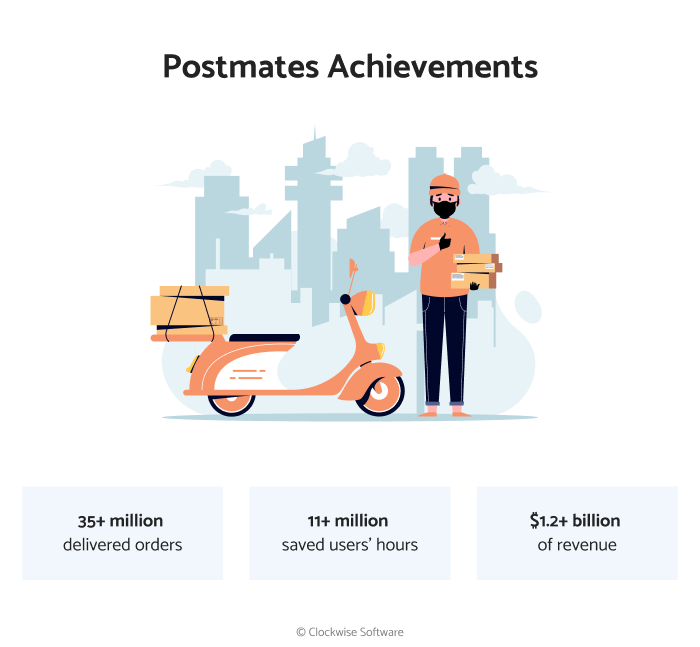
But how did it all happen? And what steps were taken to distinguish the app in the market and win users' attention? Let's make things more transparent.
1. Business pivot
Initially, Postmates founders, Bastian Lehmann, Sean Plaice, and Sam Street were about to launch a real-time tweet curation platform. They rolled out the public beta version of Curated.by in 2009 and even met their first angel investor. However, after several following rejections from investors, the founders decided to shut down Curated.by and focus on something more demanded.
The idea of a Postmates-like app came to Lehmann's mind many years before launching it. The founder says that the "boom in smartphones made all of this possible." Originally, he thought it to be a ride-hailing platform, and later, it grew to a well-thought on-demand food delivery application.
Unlike Curated.by, the idea of Postmates attracted funds actively.
What can startups learn from that? It's ok to choose the wrong direction. Once you start your business, many hidden details may show themselves, as well as many potentially profitable niches may appear. Don't be afraid to build an app like Postmates even if your first attempt to change the market with your app was unprofitable.
2. "Anti-Amazon" program with Postmates API
In 2014, Postmates released Postmates API. It helped numerous small businesses integrate location-based features and on-demand delivery services in their processes and compete with market leaders like Amazon.
"Amazon would not have been possible without FedEx or UPS. Imagine what can be built on top of Postmates.", said the app's co-founder.
What can startups learn from that? Even if there's an absolute leader in the industry you'd like to enter, a chance for you to succeed still exists. Postmates focused on providing effective services to small businesses that needed it most. Building a delivery app like Postmates, focus narrowly, too. You can either target specific regions or a particular group of users, satisfy unique demands, etc. Another actionable tip is to come with a unique product, or unique features, following the example of Postmates API.
3. Total funding
Success doesn't come easy. Years of product improvement led Postmates to a high position in the market. Each new version of an app, each upgrade attracted more and more investments:
| Year | App's version and upgrades | Raised funds |
| 2010 | Curated.by in private beta | N/A |
| 2011 | Postmates simple delivery app | Over $800,000 |
| 2012 | Postmates GetItKnow app available for couriers | $1.2 million |
| 2014 | Postmates available on Android devices. Postmates API launch | $16 million |
| 2018 | Postmates expanded to over 100 cities in the US and Mexico | $300 million |
| 2019 | App's estimated value exceeded $1.85 billion |
What can startups learn from that? It takes time and money to develop a full-featured app. If you start with a limited budget only, the point is to roll out an MVP, a minimum viable product, to raise initial funds. Then, invest raised money in each new version of an app, and attract higher investments, just like Postmates did.

Wonder how to start working on MVP? Keep reading. We've got some beneficial tips for you below.
4. 2020: Acquisition by Uber
Now, Postmates is a part of Uber. The price of the deal reached $2.7 billion. With Postmates, the world-known transportation unicorn Uber becomes more powerful and gets an opportunity to keep a head above the water rivaling with JustEat.
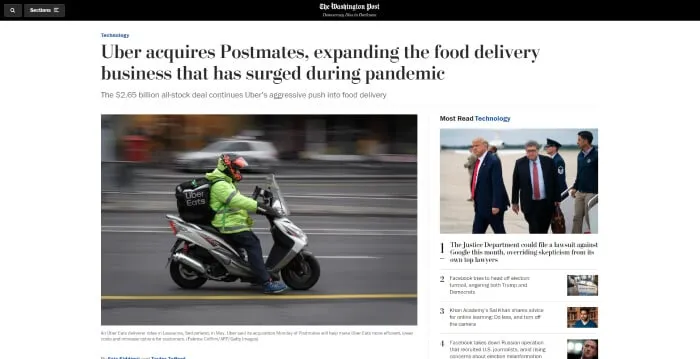
"We're thrilled to welcome Postmates to the Uber family as we innovate together to deliver better experiences for consumers, delivery people, and merchants across the country," says Dara Khosrowshah, CEO at Uber.
What can startups learn from that? Focusing on defined location, succeeding in a particular region, or a narrow niche, your simple app may become a part of something ginormous in the future! Even investing not more than a few thousands of dollars in your app, you have a chance to be acquired by a giant like Uber and multiply your revenue.
The critical thing to do is to launch your app right in time. And that's another point where MVP can help.
Would you like to find out more about prices for MVP development?
Contact us for detailed estimations.
How to build an app like Postmates: steps to successful MVP
Earlier, we've mentioned that it is essential to focus on users from the defined region, rural area, or city. Hyperlocal turns to a new trend for eCommerce and delivery apps. COVID-19 and post-pandemic conditions supported the establishment of a hyperlocal business model. So first and foremost, think about the area you would like to focus on.
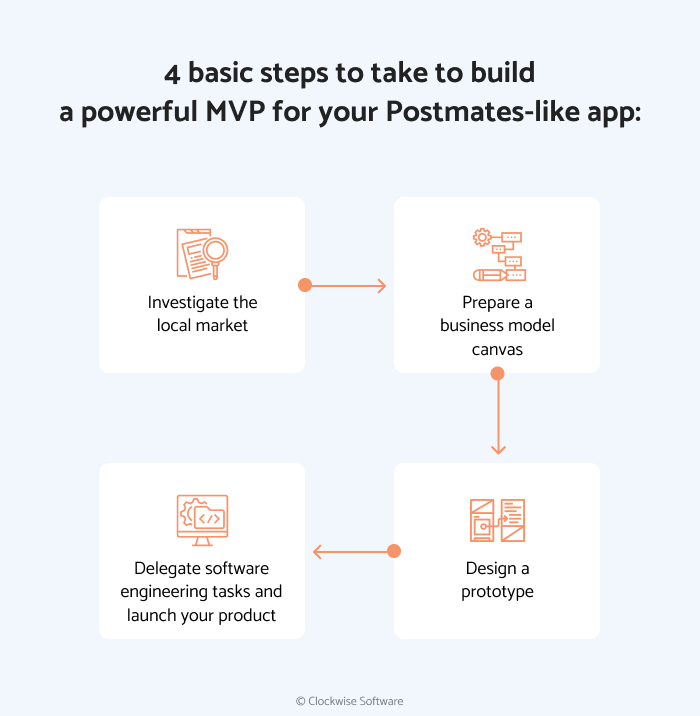
Then, proceed with our step by step guide:
Investigate the local market
Once you've set up the focus, find out whether similar applications operate in the region. Involve local communities, browse the PlayMarket, and talk to local business owners. Make sure to get answers to the following questions:
- Is there a real demand in your app like Postmates?
- Are there any similar apps in the market?
- If there are, what's the community's feedback about them?
- If there aren't, would local restaurants and groceries use your services for on-demand delivery?
If there are potential rivals who own a significant market share, try their apps. Study its UI/UX, its strengths and weaknesses, and take a look at users' opinions in app markets or Facebook communities. Find a way to launch a better application, with more attractive UI/UX design and more opportunities for users. If your app isn't competitive, you never get a piece of a market share.
Get to know your competitor to win a war without a single battle.
Create your business model canvas
They say that failing to prepare you prepare to fail. So take your time to think carefully about 9 essential elements of your business and create a business model canvas for your Postmates-like app:
Key partners
A dependable partnership is a thing no business can succeed without. In a case with a delivery app like Postmates, your main partners will be:
- Restaurants/grocery stores/other shops, depending on your idea and requirements
- Couriers, either contractors or hired personnel
Key activities
Put down your urgent tasks here, for example:
- Building cooperation with expert engineering team for high-quality application development;
- Reaching out to potentially interested restaurants or stores, and establishing collaboration with them;
- Hiring delivery stuff;
- Acquiring first orders;
- Creating an online marketing campaign etc.
Key resources
Human and financial resources, together with the intellectual or physical property you own at the very beginning, belong in this section. Define your initial budget, information about the engineering team, and equipment list.
Value proposition
On your app, there will be three different groups of users: restaurants, couriers, and customers. What value will your app provide to each of them? Tell what you think about your value proposition here.
Take a look at the simple example of how to organize the value proposition on your Postmates-like app's MVP
|
Value for restaurants |
Value for courier |
Value for customers |
|
Saved money on own delivery; Additional orders; Wider customer base |
Flexible work hours; Extra income/ high and stable income |
Social distancing; Special discounts/ coupons etc |
Customer relationship
Describe how users will interact with each other in your app.
- Chat-based direct communication between users
- Automated order placement
- Reviews and ratings
- Customer support
Promotion channels
Launching a business like Postmates, you promote your idea via:
- Mobile app
- Company's website and social media profiles
- Cooperation with influencers or other brands
Customer segments
Draw a buyer persona here. Think about how your potential users look like, how old they are, what they are interested in, and what apps they typically use. Thorough research and brainstorming devoted to buyer persona will help you provide a better, more personalized experience than any similar app.
Cost structure
There are several essential things you need to invest money in:
- Software development and maintenance cost;
- Salaries for employees or contractors you work with, including couriers, communication managers, etc.
Revenue streams
That's the most satisfying part of the entire canvas. Here, you show how you plan to make money with your app.
Depending on a business model you choose, it may be:
- Fixed fee or percentage from each delivery;
- Advertising fees from restaurants or grocery stores you promote on your app.
Combine several monetization models to increase your profit. Add gamification to engage users with in-app currency, and measure each stream's profitability.
Here's the template of a business model canvas. Download and print it, and fill it with essential information:
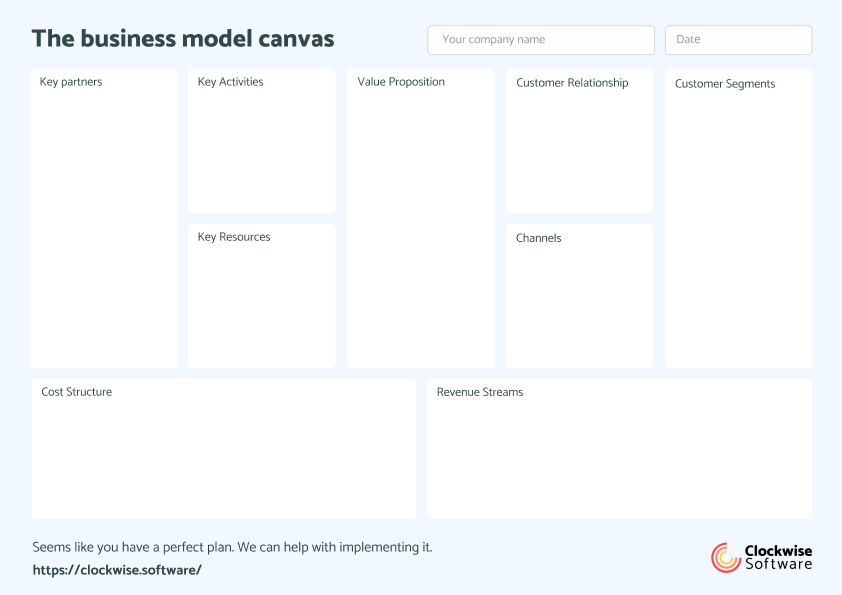
This is it. You are one step closer to a successful app.
Create a prototype
Once you've got acquainted with your potential customer's needs and preferences, build an app's prototype or a sketch. Discuss this task with an expert business analyst. This person helps to identify the user's pain points and ways to heal them with your app. Besides, a business analyst is familiar with similar applications and may help you clarify your vision on a perfect app's design.
Then, this task goes to an app designer. Designers listen to your wishes and requirements and turn the flow of ideas into a picture on a laptop screen. They create the mock-up, build each screen's interface, and show the connection between these screens.
At this stage, your idea is expressed in a digital picture.
Proceed with MVP development
With a ready-made app's prototype, you can start working on MVP.
As we've mentioned it above, your project includes two critical components:
- A business website where you describe the existing problem and offer an affordable solution, promote your app, and share some business insights;
- And a mobile app that serves the needs of restaurants, couriers, and customers.
You can choose between native, web, and hybrid development approaches. We recommend considering hybrid software development as the cost-effective and at the same time efficient approach.
Besides business analyst and designer, your engineering team may include:
| Position | Tools and technologies | Scope of work | Number of specialists in your team |
| Front-end developers | HTML/ CSS, JavaScript, JavaScript frameworks like Vue/ Angular/ React etc. | User interface development | 1-2 |
| Back-end developers | Node.js, PHP, Laravel, etc. | App's architecture development, connection to a database, all the processes that happen "behind the curtain." | 1-2 |
| QA engineer | Test management tools like TestLink or TestRail, defect tracking tools, MS Excel, etc. | Ensuring the app's quality | 1 |
| Project manager | Jira, Trello, Redmine, etc. | Team's communication, time tracking, wikis and task lists development, control over the engineering process | 1 |
Starting with 4 to 6 specialists, you can extend the tech squad to 10 or even more people later, when your app will bring you money.
At the same time, you can involve full-stack specialists to deal with both front-end and back-end development tasks. This helps you optimize your resources and take most from the development process.
App like Postmates: features for your MVP
A sharp question is how to pick features for your MVP. Remember that building an initial version of your app, you must focus on crucial functionality only. On this step, you develop vital features only to attract first users and initial investments. Later, with more financial resources for growth, you'll add some more advanced features.
Features for restaurants
- Registration and sign in
- Restaurants profile with customization features
- Menu section with detailed descriptions and photos
- Delivery status and notifications
- Payment functionality and integration with POS
- Reviews and rating
Features for couriers
- Registration and sign in
- Courier's profile with order story
- Notifications about new orders
- Accepting/ rejecting orders
- Updating order status
- Reviews and ratings
Features for customers
- Registration and sign in
- Personal profile with Favorite Restaurants section
- Search and filters
- Placing an order
- Payment functionality
- Access to delivery status
- Reviews and ratings.
Some of the features, like registration, profile, chats, and payment, are the same for all three groups of users. However, there are different features as well. Location-based functionality integrated into your app will track the courier's location, build the optimized routes from a restaurant to the user's address, and calculate the approximate delivery time and delivery price.

Creating payment functionality make sure to accept the most popular payment methods. Would you like to find out more about payment gateway integration in your app? Check our recent report.
App like Postmates: mistakes to avoid
When you are about to start the app development process, take as much as you can from Postmates' story. In this section, we highlight the complaints and issues Postmates struggled with. Being fully aware of the app's weaknesses, you can develop a more viable solution.
Troubles with UX
Before a massive re-design in 2017, users couldn't enjoy the experience with Postmates. There were several hard-to-solve troubles:
- Unorganized feed didn't provide users with enough assortment and information;
- Complex menu structure made checkout time-consuming and frustrating;
- Web, Android, and iOS versions differed in terms of features and design.
When creating your app like Postmates, prioritize not only appearance but convenience as well. It means that your business analyst and app designer should create a seamless UI and UX design for your product.
Restaurants complaints
Most of the on-demand delivery businesses signed contracts and agreements with restaurants. But not Postmates.
Surprisingly, such a big company didn't ask for permission from restaurants. Customers could order a meal from any place nearby, couriers delivered it, and very often in bad conditions; therefore, restaurants received many complaints without having any idea about the delivery.
When providing on-demand delivery services, keep in mind to make it all legal. GDPR, agreements, and trustworthy relations should build a ground for your viable business.
Monopolistic behavior
In 2020, Postmates and several more delivery market leaders were accused of monopolistic behavior. According to a lawsuit, the companies made it impossible for smaller businesses to enter the market, limited consumer choice. They forced restaurants to keep dine-in prices the same as delivery prices. Meanwhile, restaurants were charged a 13-40% fee per each order.
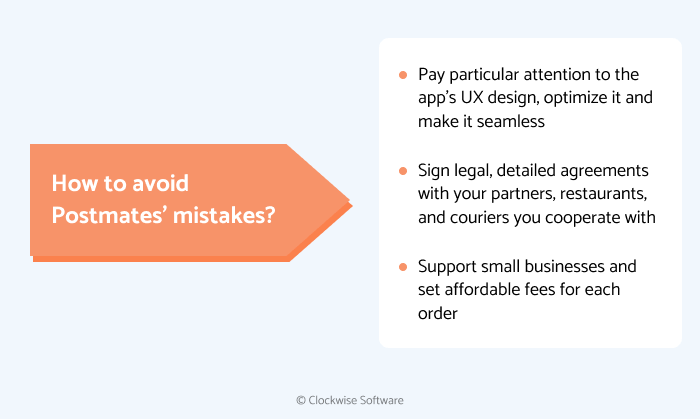
On your way to a successful business, provide reputable services, and set affordable fees. Offer attractive conditions for restaurants to solve the chicken and egg problem and win their attention.
In conclusion
Probably, there are two more bothering questions that drift through your mind when reading this article:
- How much time do you need to invest in MVP development?
- And how much does it cost to launch your app like Postmates?
The answers vary in each particular case. The precise numbers depend on your requirements, team expertise, and market specifics. However, we've analyzed the typical cases and estimated the approximate time and cost for an MVP development:
- It takes 1000+ development hours to launch MVP with basic features and start to raise funds;
- The software development outsourcing model allows optimizing your cost and building a simple MVP for $45,000+.
Would you like to find out more?
Share your vision with us, and let's calculate app development time and cost together.
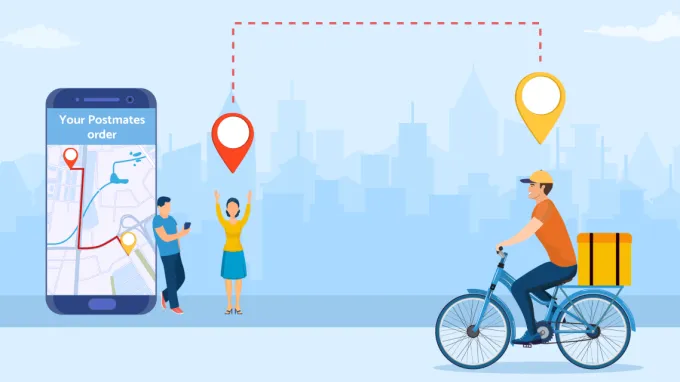
Any questions unanswered?
Let's discuss them
